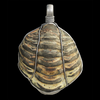The Mysterious Dodecahedrons From Across Ancient Rome

A typical Roman dodecahedron. (image credit: Carole Raddato)
Post Author - Peter Bashaw
The ancient Romans left behind architectural marvels, a rich philosophical tradition, and a complete pantheon of gods and heroes, but among their many relics, one remains truly mysterious. The Gallo-Roman dodecahedrons refer to a series of copper alloy metallic objects that have been found throughout the ancient Roman world, particularly in what was Gaul. They all have a uniform dodecahedron shape with 12 pentagon-shaped sides, each with a hole of different sizes and twenty vertices topped with knobs. Why they were built has never been conclusively explained.
There have been 130 or so dodecahedrons discovered, and seemingly as many explanations for their use. Were they a measuring tool, a head of a mace, a decorative ornament, or any number of other things? While the dodecahedrons do have some markings, there are no numbers or letters to be found on them, suggesting they’re not an instrument or anything used for measurement. The fact that these objects were made from valuable copper and are often found in coin hordes or graves suggests a symbolic value.
What then could the meaning of these objects be? In his system of geometry, Plato believed that four of the polyhedron shapes represented the four classical elements. The tetrahedron stood for fire, the hexahedron for earth, the icosahedron for water, and the octahedron for air. The dodecahedron, in turn, was a symbol of the totality of the universe, which was further elaborated by Alcinous, a later Platonist philosopher.
Alcinous speculated that each side of the dodecahedron symbolized one of the twelve zodiac signs, and so the shape stood in for the stars the Romans believed governed reality. Alcinous further suggested that as each pentagon can be divided into five triangles, and each of those triangles can divided into six smaller triangles in turn, a dodecahedron contains 360 triangles, itself connected to the 360 degrees in the zodiac.
In Alcinous’ writing, the dodecahedron is described as an all-encompassing symbol for the totality of the universe. Or, as others have suggested, it’s a spool for knitting gloves. The actual function or meaning of the Gallo-Roman dodecahedrons may simply never be known. So the next time you’re pondering the Roman empire, see if you can come up with a new explanation for these strange devices.
Featured Product
Magma Ocean - Isua Greenstone Belt - 3.6 Billion Years Old
Cool Things!

Scientists Discover First Ever Ancient Roman Trilobite!
It’s well known among archaeologists that the ancient Romans had a reverence for fossils. For example, it is thought they believed mammoth bones and teeth were those of dragons and cyclopes, and thus, these items were often displayed in places of power. However, researchers in Spain recently uncovered an exceedingly rare Roman fossil artifact from an unlikely place.

Denver Museum Finds Dinosaurs in their Backyard!
For patrons of a popular Denver museum, newly discovered dinosaur fossils are quite literally in their backyard!

Neolithic Vegetarians: Learn About the Wooden Tools Used by Early Humans!
When you think of the Stone Age, scenes of Neanderthals chasing down great beasts of old for food and furs might come to mind. Many studies have shown the invention and development of stone tools were essential to early humans’ efforts to hunt animals, but according to a recent study, that perspective may have an overbearing presence in the perception of the Stone Age.
Specimen Deep Dives

The Hollywood Sign: The Story of a City's Symbol Hollywoodland

Building Disneyland

When the Sky Split in Two: The Tunguska Event
Long Form Articles

The Artist Behind the Macintosh: Susan Kare and Apple Computers
While the two Steves, Jobs and Wozniak, are the most well known faces behind Apple computers, equally important to the products and culture of the company were those who crafted the experience of using their computers through design. The most notable of these visual architects was Susan Kare, a designer responsible for “humanizing” Macintosh computers.

Can I Lick It? Yes You Can!
Have you ever been unable to tell if a fossil was really a fossil, but you were too embarrassed to admit it? Have you ever wanted to lick a fossil just because, but you didn’t want to risk judgment from your peers? Well, good news! You can kill two birds with one stone! Licking a fossil can actually help you determine if it’s the real deal or just another rock.

Is It Legal To Own a Meteorite: How to Start Your Outer Space Collection!
Meteorites are some of the rarest geological specimens to be found on Earth. Of course, since these stones are not of our world, purchasing them can sometimes be a confusing process. Is it legal to own a meteorite? In short, yes! Read on for help starting your cosmic collection!









